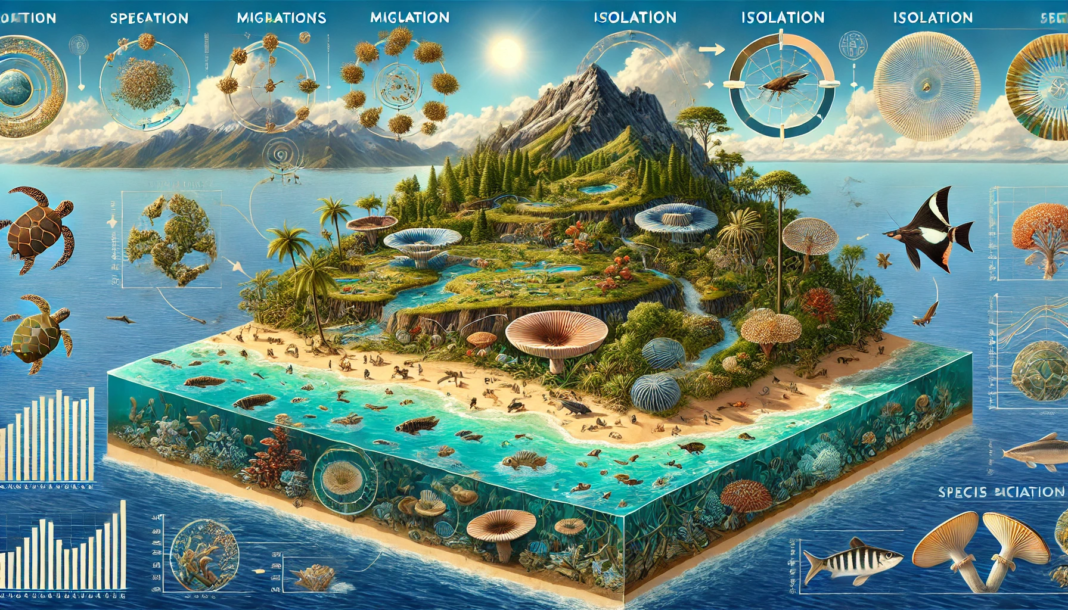How island isolation contributes to unique species evolution and biodiversity in the Caribbean? The concept of island biogeography, pioneered by ecologists Robert MacArthur and E.O. Wilson, describes the ecological relationships and distribution patterns of species on islands.
The Caribbean, a region characterized by a vast array of islands of varying sizes and distances from the mainland, presents a fascinating case study in island biogeography. The isolation of these islands has contributed significantly to the evolution of unique species and high biodiversity. This article explores how the geographic isolation of Caribbean islands influences species evolution and biodiversity.
The Theory of Island Biogeography
The theory of island biogeography posits that the number of species found on an island is determined by the island’s size and its distance from the mainland or other islands. Two main processes govern this: immigration and extinction. Larger islands closer to the mainland tend to have higher immigration rates and lower extinction rates due to more available resources and diverse habitats. Conversely, smaller, more isolated islands often have lower immigration rates and higher extinction rates, leading to distinct species compositions.
Factors Influencing Island Biodiversity
1. Geographic Isolation
Geographic isolation is a primary driver of unique species evolution on islands. The Caribbean islands, separated by vast stretches of ocean, act as natural barriers to gene flow between populations. This isolation can lead to allopatric speciation, where new species arise due to geographic separation. Over time, isolated populations may undergo genetic drift and natural selection, leading to the development of unique adaptations and, ultimately, new species.
For example, the Cuban solenodon (Solenodon cubanus) is a small, nocturnal mammal found only in Cuba. Its isolation on the island has allowed it to evolve distinct characteristics, such as a venomous bite, making it one of the few venomous mammals in the world.
2. Island Size and Habitat Diversity
The size of an island and the diversity of its habitats significantly influence its biodiversity. Larger islands, like Cuba and Hispaniola, offer a wide range of habitats, from tropical rainforests and savannas to mountains and coastal ecosystems. This habitat diversity provides niches for various species, promoting high levels of endemism. For instance, the island of Hispaniola, shared by the Dominican Republic and Haiti, hosts over 6,000 plant species, many of which are endemic.
3. Adaptive Radiation
Adaptive radiation is another crucial process in island biogeography. It occurs when a single ancestral species diversifies into multiple new species, each adapted to different ecological niches. The Caribbean’s isolation and diverse environments have fostered numerous instances of adaptive radiation.
A classic example is the Anolis lizards in the Caribbean. These lizards have radiated into a wide variety of species, each with unique adaptations suited to different microhabitats, such as tree trunks, grasslands, and leaf litter. This radiation has resulted in a remarkable diversity of Anolis species across the islands.
4. Founder Effects and Genetic Drift
The founder effect occurs when a small group of individuals colonizes a new habitat, leading to a reduced gene pool. On isolated islands, the limited genetic diversity can lead to unique evolutionary paths, as seen in the Caribbean. For instance, the Jamaican boa (Chilabothrus subflavus) is a species of snake found only in Jamaica. The isolation and small population size have resulted in distinct genetic characteristics that differentiate it from mainland relatives.
Case Studies of Caribbean Island Biodiversity
1. Cuba
Cuba, the largest island in the Caribbean, boasts a high level of biodiversity and endemism. The island is home to numerous endemic species, including the Cuban crocodile (Crocodylus rhombifer), the Cuban trogon (Priotelus temnurus), and the Cuban solenodon. Cuba’s diverse ecosystems, ranging from coastal mangroves to mountainous rainforests, provide a variety of habitats that support this rich biodiversity.
2. Puerto Rico
Puerto Rico, another biodiversity hotspot, hosts a range of unique species, such as the Puerto Rican parrot (Amazona vittata), one of the most endangered birds in the world. The island’s isolation has allowed for the evolution of distinct species and subspecies, particularly in its montane regions and coastal habitats.
3. The Lesser Antilles
The Lesser Antilles, a chain of smaller islands, exhibit notable examples of species diversification. The Lesser Antillean iguana (Iguana delicatissima) is an example of an endemic species that has evolved separately from its mainland relatives. Each island in the Lesser Antilles has its unique flora and fauna, shaped by its specific environmental conditions and isolation.
Conservation Challenges and Efforts
The unique biodiversity of Caribbean islands faces several threats, including habitat destruction, invasive species, climate change, and over-exploitation. The limited range and small population sizes of many island species make them particularly vulnerable to these threats.
Conservation efforts in the Caribbean focus on protecting habitats, controlling invasive species, and implementing breeding and reintroduction programs. Organizations like the Caribbean Biodiversity Fund and various national conservation agencies work to preserve the region’s natural heritage. Protected areas, such as national parks and wildlife reserves, are crucial in safeguarding critical habitats and species.
For example, the El Yunque National Forest in Puerto Rico is a protected area that provides habitat for numerous endemic species. Similarly, the Desembarco del Granma National Park in Cuba is a UNESCO World Heritage Site known for its rich biodiversity and unique karst formations.
Conclusion
The Caribbean’s island biogeography has created a region rich in unique species and high biodiversity. The isolation, varying island sizes, and diverse habitats have led to the evolution of many endemic species, making the Caribbean a significant area for conservation and biological study. However, these ecosystems face numerous threats, and concerted conservation efforts are essential to preserve the region’s unique natural heritage. Understanding the principles of island biogeography helps us appreciate the complexity and fragility of island ecosystems and underscores the importance of protecting them for future generations.
How does island biogeography influence species evolution in the Caribbean?
Island biogeography influences species evolution by creating isolated environments where species can evolve independently. Geographic isolation leads to allopatric speciation, where species diverge due to lack of gene flow. Unique adaptations can arise as species adjust to specific island conditions, resulting in a high level of endemism.
What is allopatric speciation, and how does it occur in the Caribbean?
Allopatric speciation occurs when populations of a species become geographically isolated and evolve into distinct species. In the Caribbean, island isolation separates populations, allowing genetic drift and natural selection to drive evolutionary changes. Over time, these isolated populations develop unique traits, leading to new species.
Why are Caribbean islands considered biodiversity hotspots?
Caribbean islands are biodiversity hotspots due to their rich variety of habitats, including rainforests, coral reefs, and coastal areas. The isolation of these islands promotes speciation, resulting in a high number of endemic species. The region’s diverse environments support a wide range of flora and fauna, contributing to its overall biodiversity.
What are some examples of unique species found in the Caribbean?
Unique species in the Caribbean include the Cuban solenodon, Jamaican boa, Puerto Rican parrot, and Anolis lizards. These species have evolved distinct traits and adaptations due to the isolated environments of their respective islands.
What threats do Caribbean island ecosystems face?
Caribbean island ecosystems face threats from habitat destruction, invasive species, climate change, and over-exploitation. These factors can lead to the loss of biodiversity and the degradation of critical habitats. Conservation efforts are essential to protect these unique ecosystems and their species.
How are conservation efforts helping to protect Caribbean biodiversity?
Conservation efforts in the Caribbean include establishing Marine Protected Areas (MPAs), coral restoration projects, promoting sustainable tourism and fishing practices, and addressing climate change impacts. These initiatives aim to protect habitats, restore damaged ecosystems, and promote the sustainable use of natural resources.

